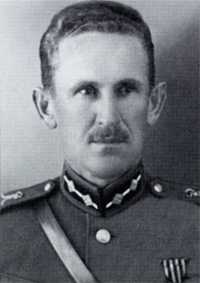Ludvigs Bolšteins
| Ludvigs Bolšteins | |
|---|---|
 | |
| Born |
February 5, 1888 Sesava parish, Russian Empire |
| Died |
June 21, 1940 (aged 52) Rīga, Latvia |
| Buried at | Brothers' Cemetery |
| Allegiance |
Russian Empire White movement Latvia |
| Service/branch | Army |
| Years of service |
1912 — 1913 and 1914 — 1917 1917 — 1918 1918 — 1920 and 1925 — 1940 |
| Rank | General |
| Wars |
World War I Russian Civil War Latvian War of Independence |
| Awards | Order of Saint Stanislaus (III class (with lances)), Order of St. Anna (III and IV (with lances) classes), Order of Lāčplēsis (II, III classes), Order of the Three Stars (II, III classes), Latvian Aizsargi Cross of Merit, Legion of Honour, Order of the Cross of the Eagle (II class), Order of the Lithuanian Grand Duke Gediminas (II class), Order of the White Rose of Finland (I class), Finland Suojeluskunta Cross of Merit, Poland Cross of Merit (gold), Order of Polonia Restituta (III class)[1] |
Ludvigs Bolšteins (February 5, 1888 – June 21, 1940) was a Latvian general. From 1925 to 1928 Bolšteins was commander of the Aizsargi home guard, from 1928 to 1940 commander of the Latvian border guard.
Biography
Ludvigs Bolšteins was born on the February the 5th, 1888, in Sesavas parish. In 1907 Bolšteins graduated from St. Petersburgs University, where he studied in the physics-mathematics faculty. In 1912 he joined the Russian army, and was decommissioned at the end of 1913.[2]
When the World War I broke out, he was mobilised and initially he served in Daugavgrīvas fortress, later Bolšteins assisted to form Latvian riflemen battalions. He served in the 1st Daugavgrīvas Latvian riflemen battalion, where he started his service as praporshchik, but by the end of his service in the Russian army he had risen to the rank of stabskapitan.[1] During World War I was awarded Order of St. Stanislaus (III class (with lances)) and Order of St. Anna (III and IV (with lances) classes).
After the Bolsevik rise to power, he was arrested in Cēsis, but managed to escape. Subsequently he travelled to Moscow, where he along with those who refused to join the Red Army, like his former commander Frīdrihs Briedis, took a part in Savinkov's anti-bolshevik organisation.[2]
After the collapse of this organisation Bolšteins returned to Latvia on December the 28th, 1918. There he joined Latvian army. Initially he aided the formation of new units in Liepāja, and would later also serve at the front lines as a member of Kalpaks battalion. On July the 12th, 1919 Bolšteins obtained the rank of lieutenant colonel. On August the 9th he was appointed the commander of the 9th Rēzeknes Infantry Regiment. After the liberation of Rīga he was made a colonel. For the remnant of the Latvian War of Independence he served on the Latgale front.[2]
After being demobilized on September the 15th, 1920, Bolšteins took to farming in his estate in Līvbērze parish.[2] In 1925 he became the head of the Aizsargi home guard, and in 1928 became the commander of the Latvian Border guards. In 1935 he received the rank of general. During his service in the Latvian army he was awarded the Order of Lāčplēsis (II, III classes), Order of the Three Stars (II, III classes) and other Latvian and foreign decorations. After the occupation of Latvia by the USSR, he committed suicide in his office. Ludvigs Bolšteins was buried at the Brothers' Cemetery.[1]
Before taking his life, Bolšteins left death note directed to his superiors. In his letter he wrote:
| “ | To my superiors. We, the Latvians, built ourselves a brand new house — our country. Now an alien power wants to force us to tear it down ourselves. In this I cannot take part. |
” |
| —Ludvigs Bolšteins, Death note to superiors.[3] | ||
References
- ↑ 1.0 1.1 1.2 (Latvian) Library of Jelgava — Notable people of Jelgava
- ↑ 2.0 2.1 2.2 2.3 (Latvian)Biography in Order of Lāčplēsis home page
- ↑ (Latvian) Museum of the Occupation of Latvia — Copy of general Bolšteins death note